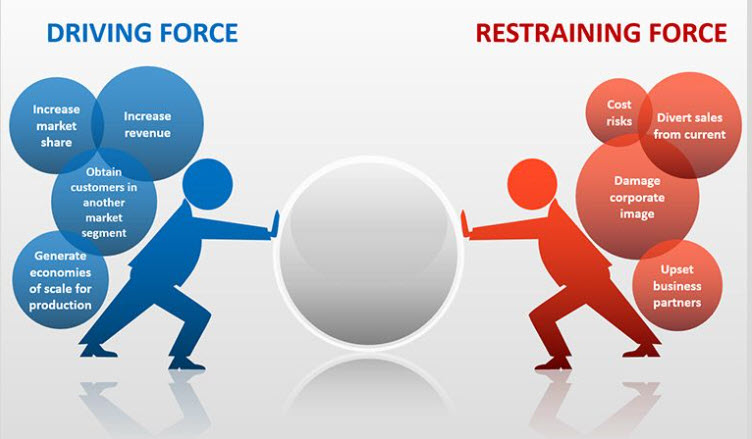Kurt Lewin’s Force Field Analysis
Basically, Force field analysis is a technique of change management initially considered by the psychologist Kurt Lewin to be practiced in social situations. No doubt it is a very significant strategic tool that can be used for understanding what is required for implementing a change in personal as well as professional aspects. Kurt Lewin’s Force field analysis is a powerful tool that can help in problem solving where the outcome eventually will be a change or implementing a new solution.
This method works on the basis of the assumption that every situation is an outcome of forces in favor and in contradiction of the existing situation being in equilibrium. It is stated by him that “A culture is not a painted picture; it is a living process, composed of countless social interactions. Like a river where its shape and velocity are determined by the balance of those forces that make the water flow and the friction that tends to slow the water down.
- To bring about any change, the balance between the forces which maintain the social self-regulation at a given level has to be upset (Lewin, K. 1948. Resolving Social Conflicts, p.47.)
By means of counteracting the conflicting forces and increasing the positive forces, we will be able to encourage a change. In a few words, we can say that force field analysis covers the favorable and unfavorable aspects of a situation so they can be compared in an easy way. Every factor of implementing the desired change can be considered.
How to Use Force Field Analysis
When considering how to use force field analysis, then there are different steps involved in using the force field analysis while implementing a change. These stages are described below.
Defining the change
The first stage of how to use force field analysis, is to clearly define a change that we want to implement. Initially we draw a big block which represents the desired change to be implemented at corporate or individual level. The basic vision or goal of a preferred state is written down.
Brainstorming
This phase involves brainstorming or mind mapping the positive forces that are viewed favorable in implementing a change. Now these forces can be favorable arguments, advantages of the change and a person or a group supporting or benefiting from the desired change. Then we will brainstorm or mind map the negative forces that are viewed as opposing in change implementation. The restraining forces might include the shortcomings, threats, costs and causes for not implementing the desired change. Likewise, we will also consider those persons, or departments who can clash with the change or experience negative results of the desired change. These forces should be recorded then on a force field diagram.
Evaluation and Review
Next stage of how to use force field analysis is evaluating the positive and negative forces. Now based on their strength, these forces will be rated on a scale from 1 to 10. All the forces will be drawn as arrows moving towards the block in the middle, positive forces from one side and negative ones from the other side.
Strategy Development
During this step a strategy is developed to reinforce the positive forces or reduce the negative ones. In the context of favorable forces, it needs to be considered how their strength can be increased. In the other end we need to come up with ways to remove or reduce the obstructing forces.
Prioritization
In the last stage of how to use force field analysis, we have to select action steps for implementing the required change. What course of actions can be taken for accomplishing the highest impact? As a final point the most effective ideas are chosen for every force and they act as our action plan for improving the change implementation. To sum up, we will identify the required resources and make a decision about how the action steps can be implemented in practical terms.
